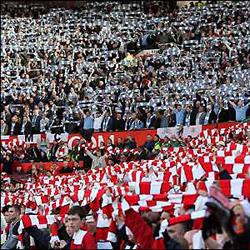
The Manchester Derby is a cultural event with roots stretching back over 140 years. What began as a local rivalry between Manchester United and Manchester City has grown into one of the most closely followed derbies in world football. This fixture embodies contrasting legacies, styles, and periods of dominance. It reflects the evolving scene of English football. Every meeting between the two sides carries historical weight and emotional intensity. The rivalry has delivered unforgettable moments.
Origins of the Rivalry
The first Manchester Derby was contested in 1881, a match that few could have predicted would spark one of the fiercest rivalries in English football. Manchester United, then playing as Newton Heath, took on a City side that was known as St. Mark’s. Over the decades, the Manchester Derby changed local bragging rights. It played pivotal roles in deciding outcomes of key football tournaments, especially during fiercely contested Premier League and FA Cup campaigns. Football became more structured and club identities evolved, the fixture gained prominence. That regularly influenced domestic title races and cup runs. The roots of animosity grew deeper with each passing decade.
In the early 20th century, both clubs tasted success but at different moments. Manchester City made headlines with their 1904 FA Cup victory and United followed up with league titles in 1908 and 1911. These early triumphs helped solidify the foundations of a rivalry that would continue to intensify. Derbies became markers of identity in the city and fans demanded superiority, season after season.
Dominance and Decline
Manchester United emerged as a dominant force, especially from the 1950s onwards. The Busby Babes, a team built by Sir Matt Busby, captivated audiences before tragedy struck in the 1958 Munich Air Disaster. The resilience shown by the club in rebuilding and eventually winning the European Cup in 1968 elevated their global status.
City, too, experienced a successful run in the late 1960s, winning the league in 1968 and the FA Cup in 1969. That era saw a tight rivalry where both teams were genuine contenders, but the balance tipped again in the 1990s as Sir Alex Ferguson’s United began their reign of dominance. With 13 league titles under Ferguson, United became synonymous with English football’s modern era and City languished in lower divisions dropping to the third tier in 1998.
Yet the story didn’t end there. The mid-2000s brought seismic change to the blue side of Manchester. With new ownership came investment, infrastructure, and a new vision. City’s transformation under Roberto Mancini bore fruit in 2012 when Sergio Agüero scored the stoppage-time winner that sealed the Premier League title. That was one of the most dramatic moments in the competition’s history and a symbolic transition in Manchester’s footballing hierarchy.
The Tactical Evolution and Recent Fixtures
Rivalry and the style and strategic complexity of both clubs evolved. Pep Guardiola’s arrival in 2016 redefined City’s play with an emphasis on possession, control, and fluid movement. Under his guidance, City reclaimed domestic supremacy and did so with record-breaking points totals and consistent silverware.
Manchester United, meanwhile, have undergone several managerial changes since Ferguson’s retirement in 2013. Though inconsistency has marked their post-Ferguson era, the club has managed significant derby wins. They thrived in matches where tactical discipline and counter-attacking football came into play. Their 2–0 victory at the Etihad in 2020 is a prime example of this, where United exploited space and struck decisively.
More recently, the 2023–24 season saw both clubs continue to play pivotal roles in the title race and domestic cup competitions. In a fiercely contested FA Cup final, United triumphed 2–1 over City. These results highlight the pendulum-like nature of the rivalry today.
Beyond the Pitch: A Derby’s Cultural Impact
The significance of the Manchester Derby extends well beyond the 90 minutes on the pitch. Economically, derby day infuses the city with energy. It draws thousands of spectators into pubs, merchandise stores, and local businesses. It’s a date marked on the calendar months in advance for Mancunians and for millions of fans around the world who follow the English game.
On a global scale, few club rivalries have captured attention with such consistency. The derby’s narrative presents a tale of resilience, rebirth, and the ongoing contest for identity in a city that lives and breathes football. The media coverage, tactical analysis, and player performances are scrutinised in detail. That further elevates its stature among football fixtures worldwide.